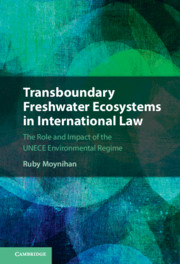 Transboundary Freshwater Ecosystems in International Law
Transboundary Freshwater Ecosystems in International Law Published online by Cambridge University Press: 01 October 2021
In no other ecosystem is biodiversity being irreversibly damaged to the extent that is occurring in inland or freshwater ecosystems. International legal frameworks are failing to reverse the current global freshwater biodiversity crisis. The ecosystem approach has emerged as a promising scientifically and socially progressive approach to managing ecosystems and the vulnerable societies that depend on them. The legal normative content and international legal status of this concept remain unclear. This chapter identifies five international legal elements of an ecosystem approach concerning transboundary freshwater ecosystems, drawing from international biodiversity, wetlands and water law which also includes fair and equitable benefit-sharing. It demonstrates how the UNECE regime provides the strongest clarification of an ecosystem approach, going beyond the UN Watercourses Convention and customary international law but benefits from interpretive clarification under biodiversity and wetlands regimes. The concept of ecosystem services is part of an ecosystem approach and the legal dimensions of this concept are examined. This chapter discusses how the ecosystem approach stimulates cross-sectoral coherence and mutual supportiveness between these different areas of law and contributes to equity in that process. It outlines how international human rights law could be relied upon to promote a stronger equity dimension for ecosystem services.
To save this book to your Kindle, first ensure [email protected] is added to your Approved Personal Document E-mail List under your Personal Document Settings on the Manage Your Content and Devices page of your Amazon account. Then enter the ‘name’ part of your Kindle email address below. Find out more about saving to your Kindle.
Note you can select to save to either the @free.kindle.com or @kindle.com variations. ‘@free.kindle.com’ emails are free but can only be saved to your device when it is connected to wi-fi. ‘@kindle.com’ emails can be delivered even when you are not connected to wi-fi, but note that service fees apply.
Find out more about the Kindle Personal Document Service.
To save content items to your account, please confirm that you agree to abide by our usage policies. If this is the first time you use this feature, you will be asked to authorise Cambridge Core to connect with your account. Find out more about saving content to Dropbox.
To save content items to your account, please confirm that you agree to abide by our usage policies. If this is the first time you use this feature, you will be asked to authorise Cambridge Core to connect with your account. Find out more about saving content to Google Drive.